When the word burns in thermonuclear fire, I’m going to miss these. Behold, a pleasant Autumn rainbow–something we don’t get very often:
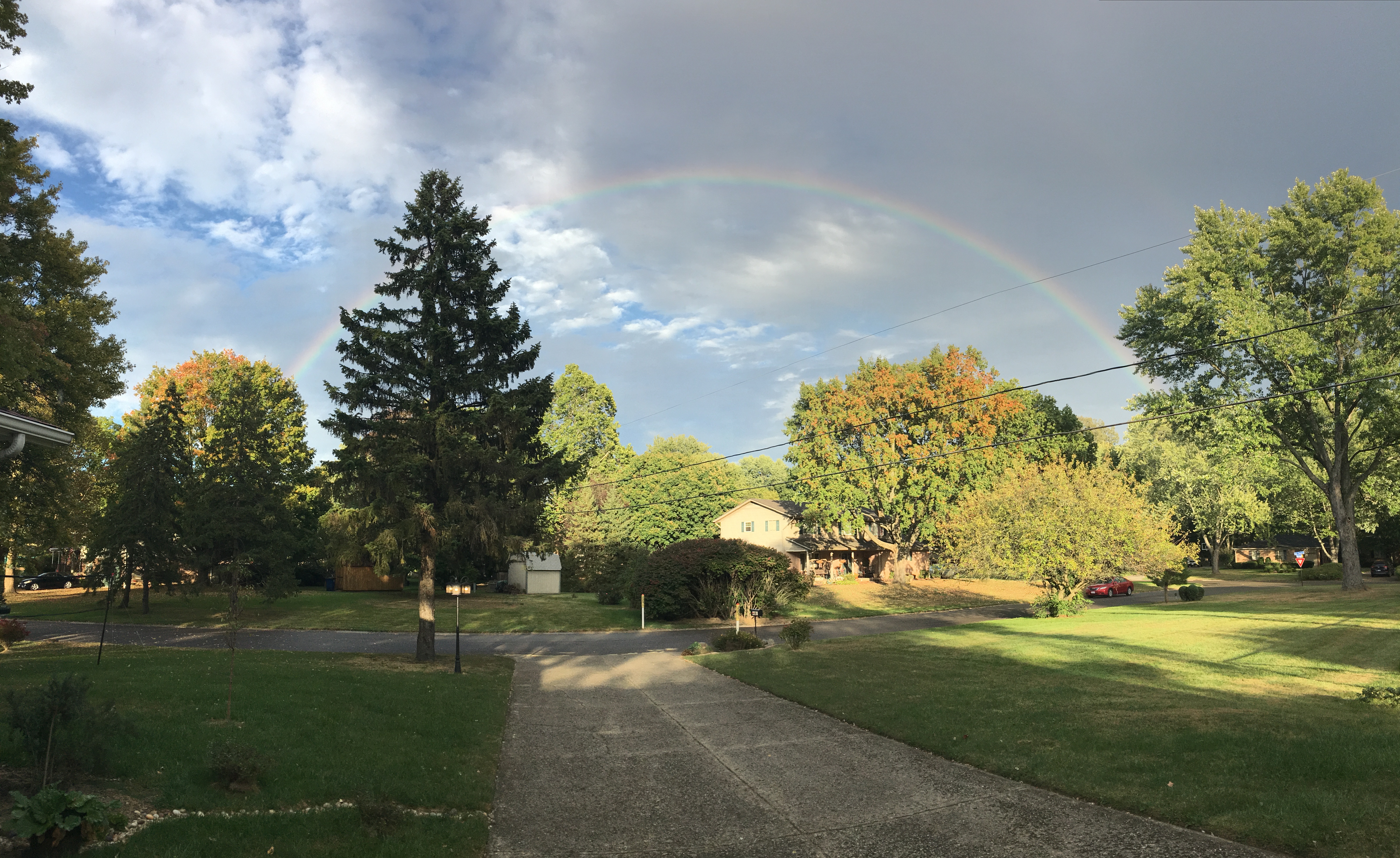
–Simon

Tales from Easement Acres
When the word burns in thermonuclear fire, I’m going to miss these. Behold, a pleasant Autumn rainbow–something we don’t get very often:

–Simon
As a species, we’re obsessed with the metaphysical–a concept that has long predated the scientific method and its analysis of the empirical…and of course the two have always been at odds. The latter offers explanations based on irrefutable perception, while the former is more supposition. Perhaps it’s because the scientific method has and always will probably fail to answer every question that could ever be conceived by the powers of runaway brain growth and abstract cognition.
But historically, the greater unease has been the possibility that a mortal might tap into the metaphysical to produce very physical consequences. It’s easy to be understanding of a deity, who presumably has the knowledge and intellect to manipulate the metaphysical in a responsible manner, but were a human to dabble in the occult and gain unearthly power over the physical, well then the conclusion could only be that this power will corrupt and the practitioner would become evil.
That’s one guess anyway, although I think the greatest influence on changing the public perception has been Christianity. Alchemists and shamen became witches and heretics. Then again, so too were prominent scientists in their day. Maybe the greatest fear then was threatening the status quo and the balance of power.
Despite the lengthy introduction, this is not a post aimed to tackle these questions. No, this is a post of inquisition, though not in the scary torture type of religious context.
I went out to split some firewood, and saw these:

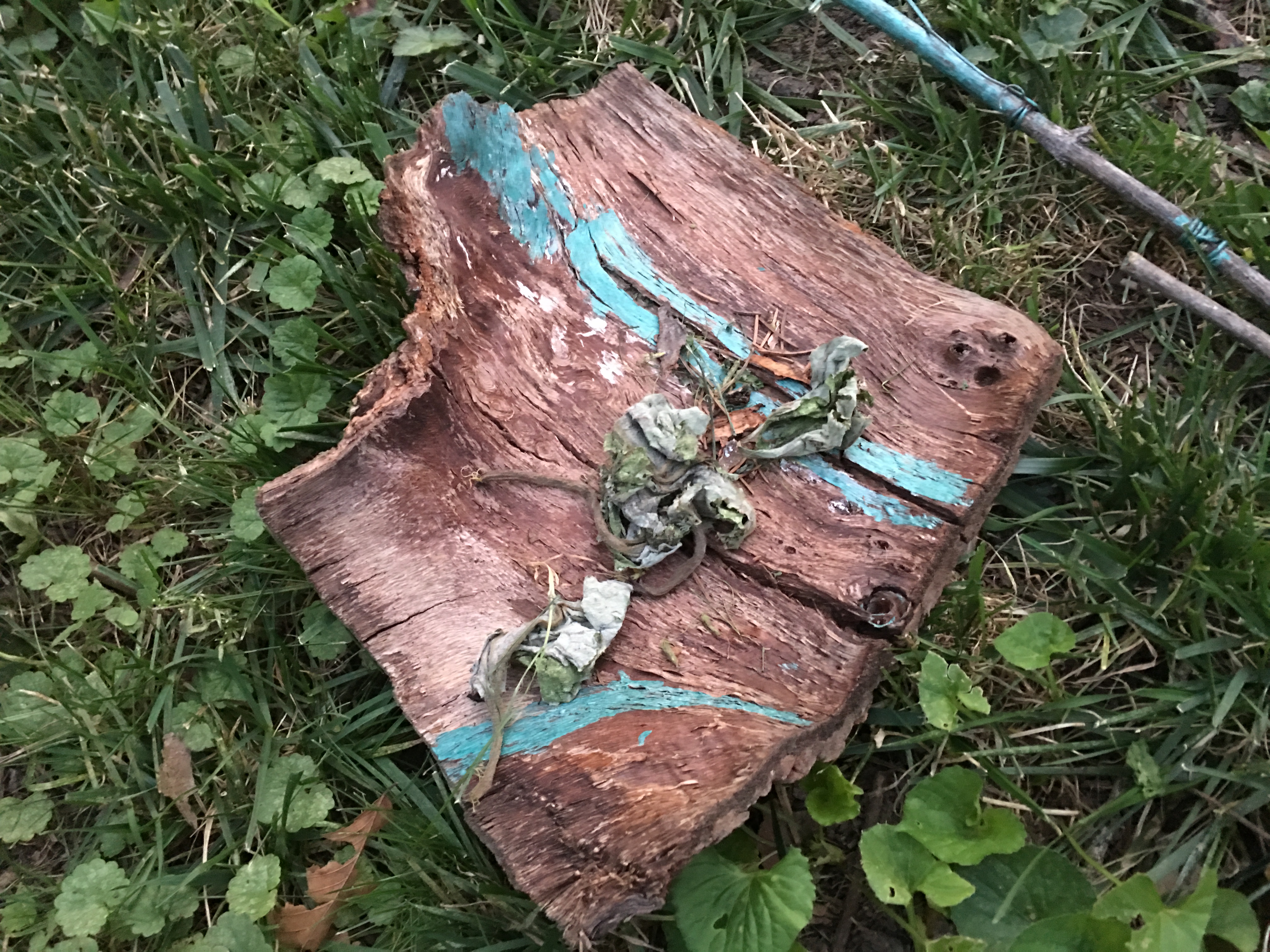
Naturally curious at what appeared to be a magic circle, potion, and wand; I asked my daughter for an explanation. Her simple answer: “It’s a spell.” Unlike what some of her more distant relatives might have, I did not start splashing her in holy water and waving a rosary. Rather, I was curious where she had learned about these things. The color of the markings even resembled woad. Interesting. I wondered what she was conjuring. Maybe she was trying to cure herself of the virus that had been plaguing her respiratory system for the last two weeks.
But upon further questioning, it was apparent that I had misheard. A child’s soft palate had lended a lisp to her words. It was not a spell. It was a stove. She had drawn a range and was cooking stew. It was no attempt to bridge the material and metaphysical, no, it was a simple emulation of the culinary arts.

I admit, I was a little disappointed. Then again, learning to cook is probably a more valuable life skill than making love potions.
–Simon
For the life of me, I couldn’t figure out a clever alliterative title to this post. All the D-words I could think of were rather derogatory (see–there’s one right there), and while I may have failed to change others’ lives with my career, like so many with hopes and dreams of grandeur, I did managed to change mine, and drastically improve its standard of living. And after all, isn’t that our prime directive as a species, before we get into all that nonsense about purpose and self-actualization that we’re spoon-fed from the time we learn to write our names?
But I’m too young for a midlife crisis. This was a mere 10 years. What happened career-wise in that timeframe? Hmm…
I joined the company as the recession hit. Large swaths of the management staff were let go. Merit raises were frozen, our insurance was overhauled (not for the better), there was a hiring freeze, and then the parent company tried to sell off the division. When that failed, they realigned it, then merged it, and ultimately spun it off. In the end, I held 6 different positions over that time. It wasn’t exactly a period of sustained economic growth.
Through it all, the company has still maintained the practice of awarding ceremonial gifts unto an employee upon reaching a milestone number of tenured years. Or rather, they send a digital catalog and the employee gets to pick out a gift. They can be a bit odd too, like sunglasses, a crockpot, or a telescope. But I, reflecting upon what I have endured to reach that point, prefer to find my own symbolic meanings and so choose something of…symbolism.
So it was that upon reaching 5 years, when I was still a call-center agent toiling away in the ranks, when every second of my time spent on the clock was tracked and reported to generate various statistics and graphs that visualized how I wasn’t working hard or quickly enough, that I chose the Bulova analog watch:

…you know, because time? Although now it occurs to me that this may already be intended symbolism, due to the watch’s ubiquity as a “years of service” award. Because I guess there isn’t really a wearable calendar.
But now, I’ve reached 10 years. Following suit on the symbolic gift appropriate choice…thing, I noticed this in the catalog:

A crystal whiskey decanter! I couldn’t think of anything more appropriate had I tried: both a symbol of what has gotten me through those 10 years alive, and going forward, a physical item to get me through the next 10 years.
Plus, it’ll annoy Liz. Win!
–Simon
I really like my indoor grow light basement setup. With the average first frost in the region to be around 10/19, I’ve been revisiting the setup and considering what I’m going to be keeping inside overwinter. And as I pondered the setup, I thought about how much easier things would be if I had a hose connected down there. And as it just so happens, it’s only about 10 feet away from the main water line.
This portion of the basement is where the laundry machines are hooked up, as well as a utility sink. The lines split off from here, feeding two external spigots, and there’s the whole house filter, the water heater, and the general myriad of lines for sinks and bathrooms. To me, the mess of copper looks like the depths of some steampunk facility.
In the chaos, the main water line passes through two spigots. The spigots are closed, with a central spigot which bypasses them–open. It looks like a setup for a water softener. I don’t know if one was ever installed, because the water here doesn’t need conditioning, but maybe it once did. Who knows? Regardless their intended purpose, it gave me an idea–could I just simply connect a hose to one of those spigots?
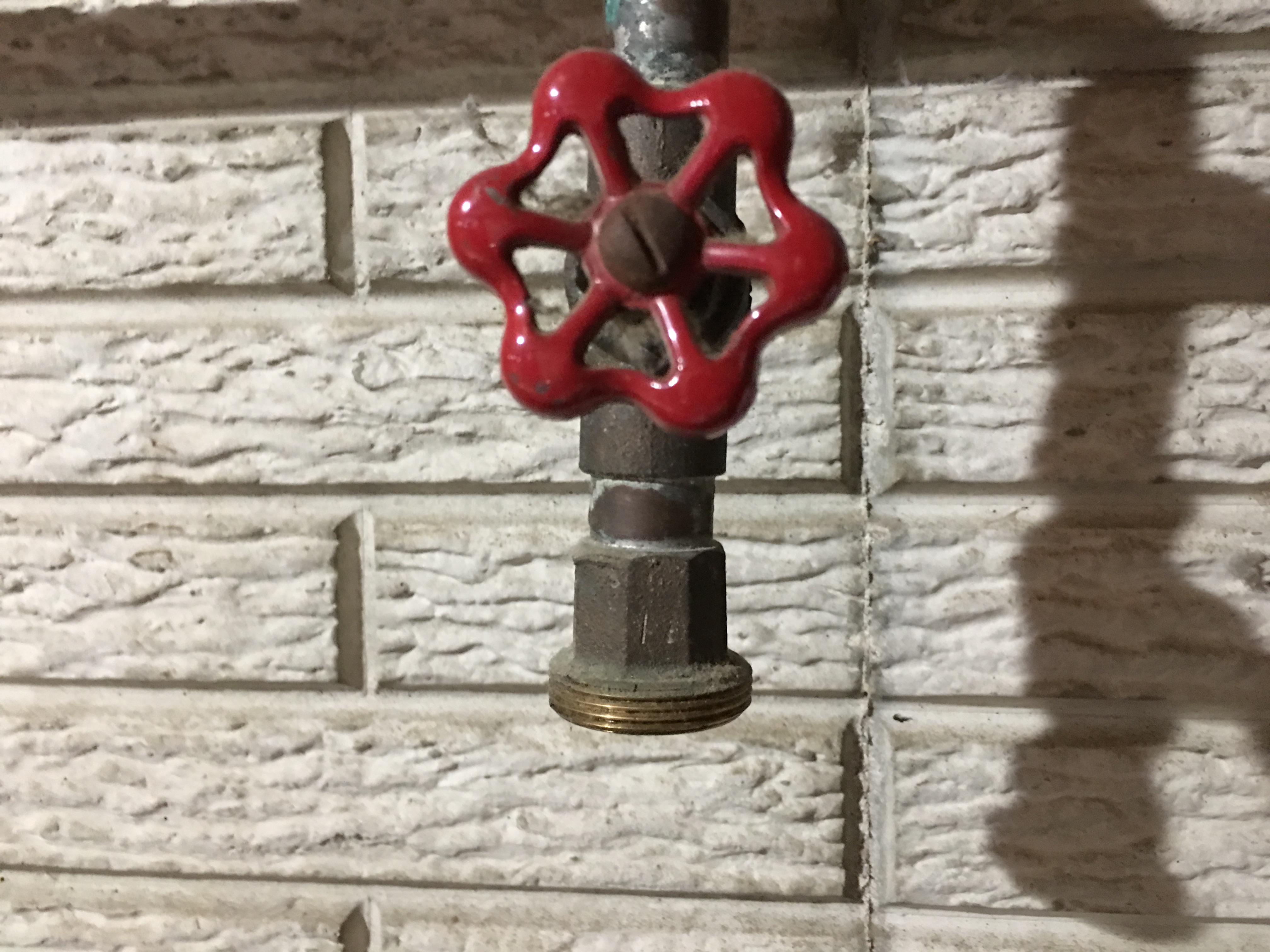
As it turns out, no. The threads were much too wide for a standard garden hose. But surely there’s an adapter, right?
Armed with this logic, I was off to Lowe’s to look at copper fittings. I quickly discovered that the maximum copper fitting size was 1 inch. Recalling how wide the spigot was, I gambled and bought a 1 inch to 3/4 inch reducer. I hurried home to see the fruition of my project, but soon determined that 1 inch was too small. Curious, why would they not make a copper fitting big enough to fit a copper spigot?
So I went to Home Depot instead. But I ran into the same problem here. None of the connectors were big enough. Staring blankly at the wall of copper, a store employee took pity on me and offered to help. I explained my plight, and he informed me that they don’t carry anything in copper bigger than one inch, but he could get me the needed size connectors in PVC.
I really wanted copper, but this project wasn’t for any high-impact application, so as long as it would work at all, I could live with PVC. So, with two PVC adapters and a brass threaded hose connector, I headed back home. I then attempted to attach the PVC to the spigot, and…it was too big. What the hell? I went up one standard size from one inch: 1-1/4. Why wouldn’t that fit? And it was only slightly too big, like 1/16 of an inch. Was this spigot metric?
I stewed over this dilemma, and concluded that I would experiment. So I wrapped the threads in a bunch of Teflon tape to fill the gap, cranked the PVC down, and filled the resultant void (due to the depth of the PVC threads) with a waterproofing adhesive. I let it cure for 24 hours. Maybe that would be sufficient.
It wasn’t. Even though I didn’t turn the water on very high, it was still the main water line, and the pressure was too great. The joint failed with a pop and I had to scurry over and shut the spigot. Curses.
Okay, experiment 2. I removed all the adhesive and Teflon. This time, I was armed with self-fusing silicone tape–something designed to seal high-pressure pipes (which I bought on a whim while I was returning the first batch of connectors). I wrapped the spigot threads with enough tape that it became an effort to crank down the PVC connector. This stuff was supposed to adhere to any surface and be completely waterproof. I let it sit for a bit, but it didn’t have any cure time so that hardly seemed to matter. This time, I decided to test it without any sealant, since the sealant itself wouldn’t hold the pressure anyway. I turned the water on, higher than I had turned it on with my last attempts.

And…it held. Huh, maybe this silicone tape is magic after all. I let the hose stay pressurized for a time, then shut it off and de-pressurized the line. I refilled the gap with sealant, figuring it might still help by adding support. And so far, it’s working as I had hoped. I’m uncertain of this solution’s permanence, and somewhat unhappy with the inelegant and hacked solution, but time will tell. And if it doesn’t hold up, then I’ll simply splice into the wash machine line instead. I know I can get proper connectors for that at least.
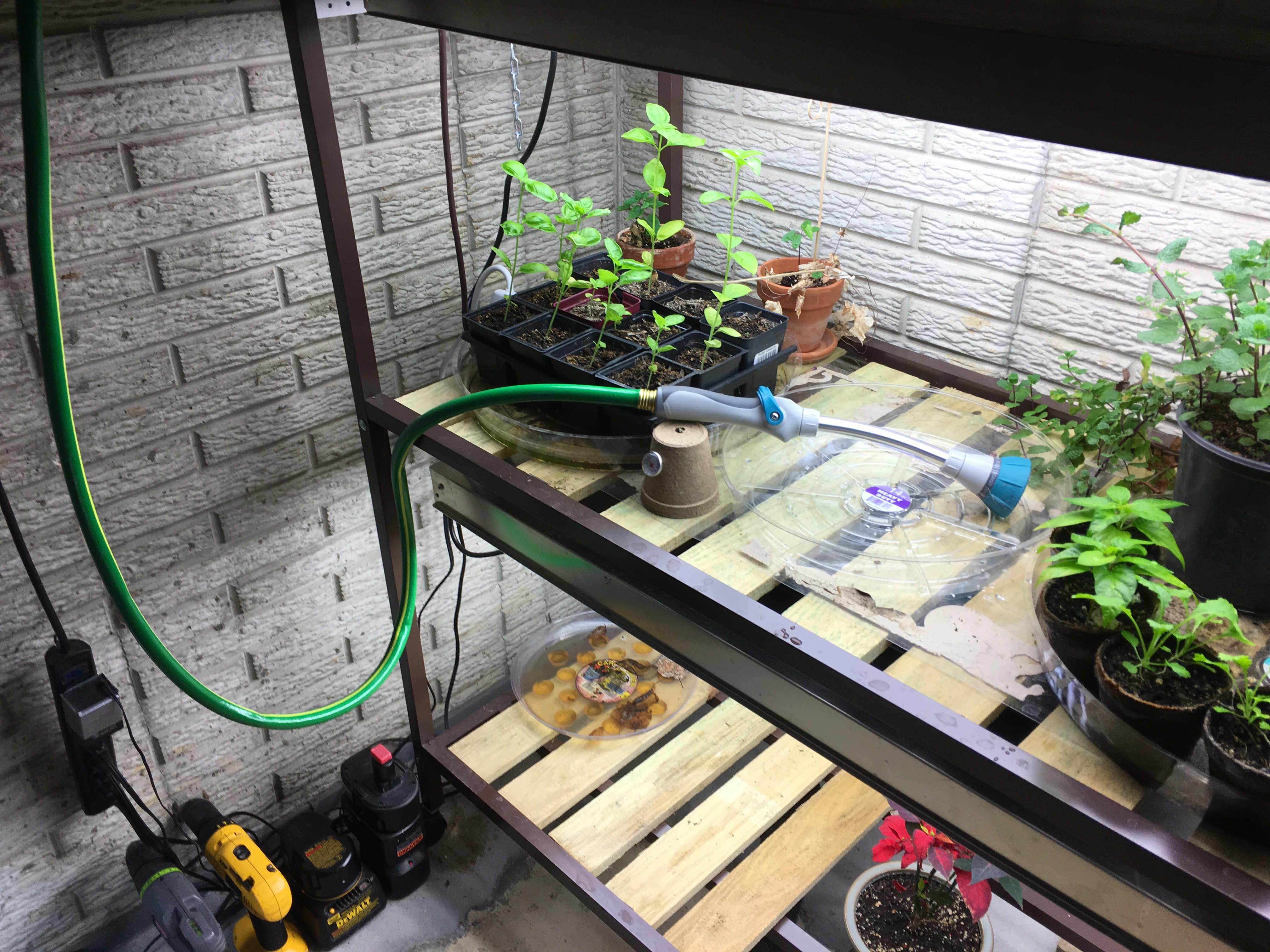
Still, the irritation lingered, and I searched for an explanation. Curiously, pipe fittings are not nearly as standard as I had thought, and the actual measurements are approximations which have changed over time. So whenever this spigot was installed, for whatever connection it was intended, is no longer a current standard. Sheesh. Maybe one day I’ll try soldering in a nice ball valve threaded for a garden hose, but for now, I don’t want to risk compromising the main water line and having to call in a professional.
Why the hell aren’t pipes all standard sizes? Another homeowner lesson.
–Simon
I thought some bladed weaponry would look good above the mantle. Dad thought some full-size babe pinups would fit the space perfectly. But ultimately, I somehow ended up with sunflowers. I suppose pictures of the reproductive parts of plants is sort of like pictures of babes…roll that disturbing thought through your brain a bit.
Admittedly, I like sunflowers. I wish I had grown some this year. And I had been living in fear that the mantle would eventually be adorned with paintings of cabins in the woods, so I can live with sunflowers.
But it’s a lengthy stretch–99 inches to be exact, and Liz had acquired 4 individual pictures. This would create a ratio that would show every slight deviation in alignment, so they had to be mounted with exacting perfection. Fortunately, OCD can be leveraged to accomplish such perfection, so out came my tool kit and the drafting equipment (paper and pencil).
Okay…99 divided into 4 equal partitions would be 24 3/4 inches, so if I measure the exact middle, 49 1/2 inches, and the height is 40 3/4 inches, then the middle is…
…Also consider the width and height of the frames, and the locations of the mounting brackets, and the distance between…
I ended up with this nightmarish blueprint:
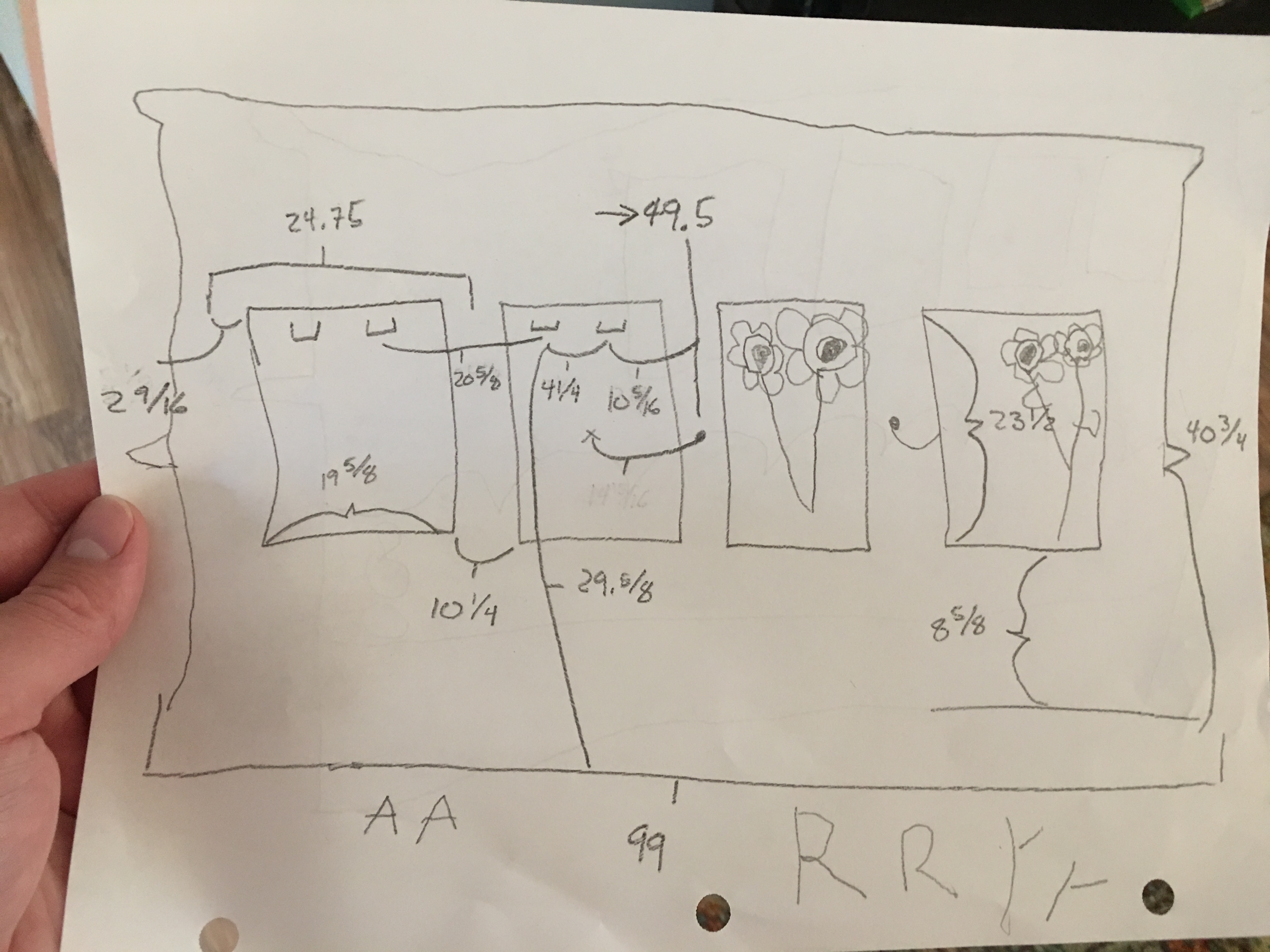
At least the frames were light so I didn’t have to worry about mounts or studs. Studs are never where they’re needed, and mounts always seem to have a 50/50 chance of ripping the drywall out.
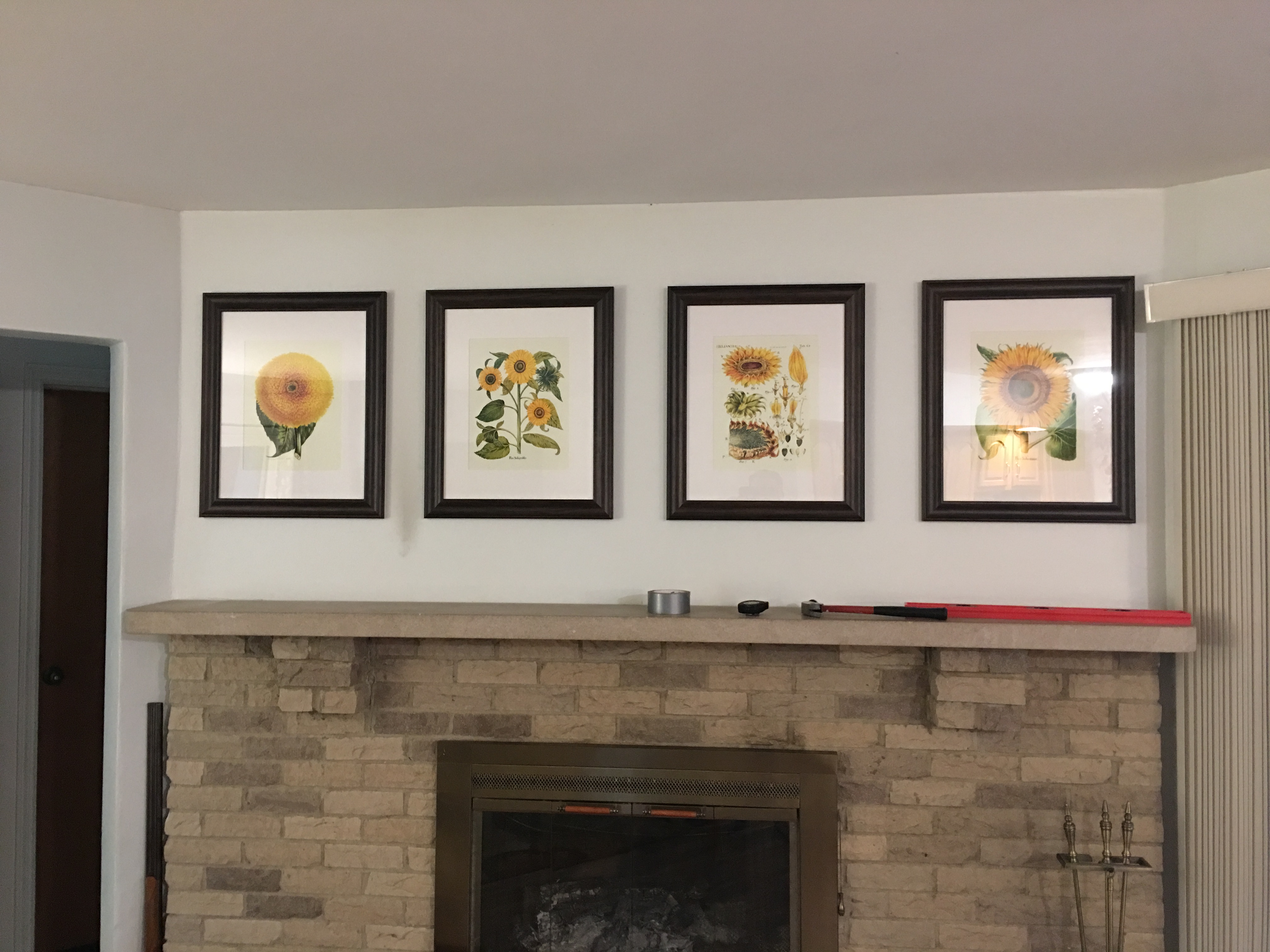
One more wall decorated.
–Simon